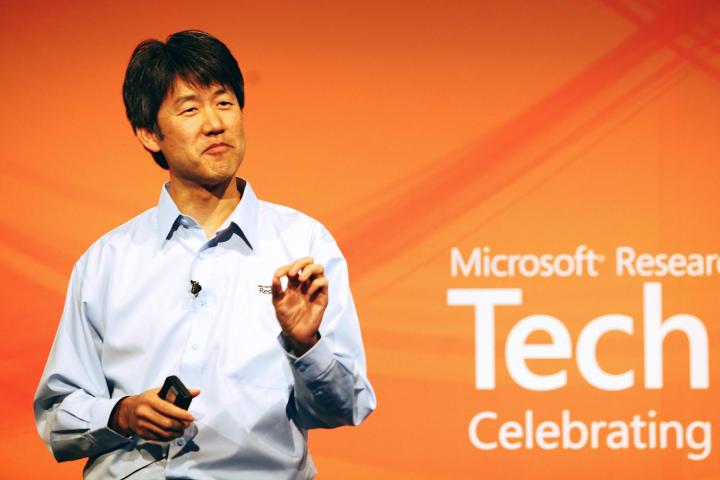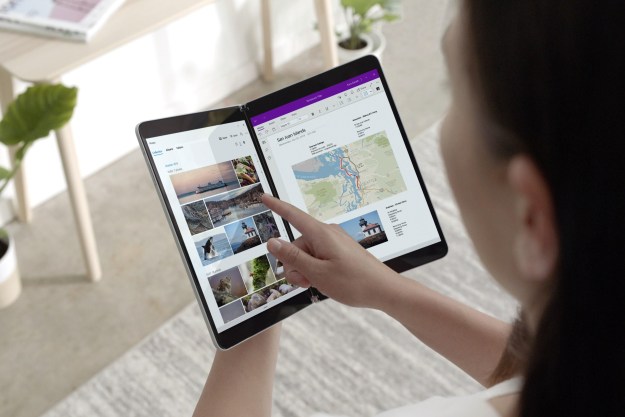
“I’m not ready to talk about Special Projects,” Peter Lee, head of Microsoft Research, told me on Monday – before he proceeded to tell me all about Special Projects.
Microsoft Research has 1,100 computer scientists, researchers, and engineers in labs all around the world. Add in 1,200 PhD student interns every year, and Microsoft’s R&D department is on the same scale as a good-sized research university. It’s responsible for some remarkable stuff – Cortana, the tech behind Kinect, and so on – yet you almost never hear from the group directly.
The international press has written tens of thousands of articles about Google X, the company’s blue-sky, moon-shot research arm that’s dabbling in anything and everything from self-driving cars to robot moon landers to a cure for death itself, but Microsoft’s own crazy projects haven’t gotten nearly the coverage.
“I like Google X. The people there are good friends of mine.”
Microsoft Research finally earned some long-overdue headlines last week, when ZDNet’s Mary Jo Foley reported on a “Special Projects” group that would tackle disruptive technology and ultimately Google X. But Lee said he’s not frustrated by all of that glowing press Google’s research guys have garnered.
“Frustrating is not quite the right word,” Lee told Digital Trends, in an interview ahead of the ribbon-cutting ceremony for MSR’s New York City office. “I like Google X. The people there are good friends of mine. Astro [Teller, “Captain of Moonshots” with Google X] took classes from me at Carnegie Mellon, he’s a great guy doing great stuff. But the missions are different. We want to make things better and ship them. That will always be primary for us. It will be secondary for them.”
Lee is a corporate vice president at Microsoft, formerly a key department head at DARPA and the guy in charge of Carnegie Mellon’s computer science department before that. He’s also as affable and charming as you could imagine, as well as unexpectedly amusing for a researcher who writes dense technical treatises with names like “Optimizing ML with Run-Time Code Generation” and “Metacircularity in the polymorphic lambda calculus.” (Published in a 1991 issue of Theoretical Computer Science – look it up.)
Microsoft Research vs. Google X
Microsoft Research’s work spans four quadrants, Lee said: One is mission-focused, work requested by other departments for example. A second field is sustaining technologies, improving testing tools for example, or machine translation ability. Then there are disruptive technologies and ultimately that moon-shot stuff.

One directive of new CEO Satya Nadella is for the group to finally put step into the spotlight, something Lee said was a great development.
“I would prefer that the world not have too much envy for Google X.”
“It’s a good thing for the industry, and it’s a good thing for all of us — to expand what people imagine is possible with technology. That’s something we want to do, and it’s something Google X wants to do. And at the same time we want to do real things that reach real people now, rather than later.”
The Special Projects group will be headed up by Norman A. Whitaker, Microsoft announced last week. Whitaker is former deputy director of the Information Innovation Office at DARPA, where he worked together with Lee way back when.
“DARPA and Microsoft Research are similar in that there is a specific focus in looking beyond the headlights to the next big thing,” explained Lee.
Cortana and machine learning
A big chunk of Microsoft Research is aimed at that blue-sky foundational research, Lee said, not concerned with business imperatives and just looking for the next big thing. Other groups work with specific mandates, tasked by senior management to help different business units with something specific.
That’s where Cortana came from.

Steve Ballmer himself tasked the team with developing a smart voice-recognition system for the Windows Phone platform, although most such collaborative work isn’t tasked from above. In a few areas there is some high-level company directive, he acknowledged. The research staff in Redmond build a feature called Interactive Classifier into Cortana, which allows a small team of non-expert engineers to do continuous evolution of the system.
“With a very few number of parameters, just a few dozen, you get a continuous improvement,” Lee said. “That’s why it’s in beta. As it gets used, every day Cortana is getting a little bit more human in its responses.”
Windows 9
Another rare, top-down command might shape the next iteration of Windows, which is likely to be called Windows 9 – although Lee declined to even confirm the existence of an update to the OS. New CEO Satya Nadella has made clear his vision of a cloud-enabled Windows. He even stressed it in his first letter to the to the company.
Yet Windows at present doesn’t rely on the cloud for computing power. Sure, there’s OneDrive, a great place to store stuff, and the Office family of apps can be run from the cloud. But unlike other Microsoft products, that’s where the integration ends.
Bing, by contrast, lives and breathes because of the hidden, back-end power of the cloud, as does Siri – and by extension, some of the neatest features of the Windows Phone platform (Android too, of course). But the desktop? Not so much.
That’ll change in Windows 9, if Microsoft Research has anything to say about it.
“One of the mission-focused activities [those dictated by other divisions within the company] is centered around something called the Enterprise Graph. It sounds really boring but for us it’s really interesting,” he said.
Presently, Windows doesn’t rely on the cloud for computing power … That’ll change in Windows 9.
Microsoft has a lot of customers that are big companies with hundreds of thousands of employees. Your smartphone may realize you take the same route to work everyday, thanks to data stored and analyzed in the loud, but Windows apps and the OS itself just don’t get it.
“Using machine learning to extract relationships, entities, key ideas being worked on and bring those to the surface in tools. Maybe even digital-assistant tools to make companies more productive and smarter. That’s one area we’re going at” for Windows 9, Lee said.
If that sounds familiar, it should: It’s how Bing processes and parses pieces of information to understand that your search for “Adam Levine news” is really for gossip about the Maroon 5 guy – and surfaces news that lets you tell your friends “dude, did you hear, he just dyed his hair!” Doing it for computers is different than doing it for the world wide web, Lee said.
“Bing tries to understand entities. When someone does a Bing search for ‘Canon 4D’ and they click the Canon Rebel link, we learn about those relationships. With enterprise there’s similar issues but with much less data. The computer science ends up being different.”
“If I write a document and I want to say, share this with the appropriate people that work with Vikram from the meeting, or say, ‘what’s trending around me at work,’ not in my personal space but at work … answering questions like that requires a very different kind of machine learning,” he said.
Beyond the algorithm
It’s not all work for Lee. To describe artificial intelligence in action, he cited the AI powering the grunts in the videogame Titanfall.
“It’s been about a week since I last played,” he acknowledged. Ostensibly, it’s an excuse to appreciate how the AI gets smarter over time. But come on. It’s Titanfall.
And besides, there’s more to Microsoft Research than just building a better algorithm or building a better phone. Lee really believes that machine learning and smarter computers could shape society, and bring us to a deeper understanding of what makes us all tick.
“We’re on the cusp of understanding something really important about human nature. It sounds pretentious but that’s a real thing for us.”
“Research is a long game.”
Editors' Recommendations
- How to set up Windows 11 without a Microsoft account
- Microsoft plans to charge for Windows 10 updates in the future
- AMD’s new Ryzen 9 7950X3D is up to 24% faster than Intel’s best
- Frustrated security researcher discloses Windows zero-day bug, blames Microsoft
- Microsoft CEO confirms big plans about the future of Windows 10 at Build 2021


